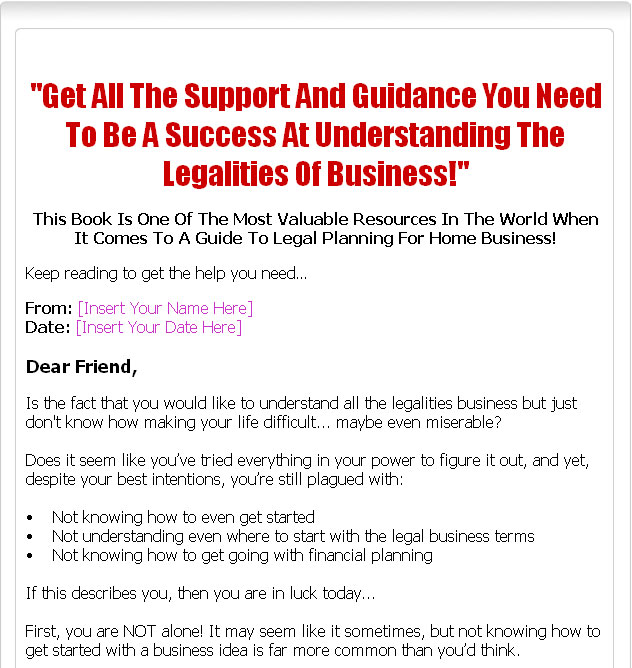Salespage Snapshot:

Table Of Contents
Foreword
Chapter 1: Legal Basics
Chapter 2: Sole Proprietorship
Chapter 3: LLC
Chapter 4: Incorporating
Chapter 5: Tax Planning
Chapter 6: Financial Planning
Chapter 7: Business Partners
Chapter8: Using Online Legal Services And Documents
Chapter 9: Why It’s Dangerous To Not Have The Legalities In Order
Wrapping Up
Sample Content Preview
Chapter 2: Sole Proprietorship
Synopsis
This is a business style that requires the individual to be declared as a single entity with the business linked for the main purpose of tax and all liability purposes. The sole proprietorship is a company in which the registration is done with the governing body of the time, in a limited liability framework of the company or corporation frame.
Sole Proprietor
Commonly the owner of the said business entity does not have to pay any income tax separate from the company but does have to have proper records of income and losses shown.
This should be reflected in the income tax returns filed. Here the owner of the business entity is inseparable from the sole proprietorship and thus is liable for any business debts the said business may incur through the course of the business lifespan.
Most new home based business entities chose this form of legal registration for its minimal requirements and legal obligations.
The main point to understand is that the owner of the business is liable in all ways to any debts incurred thus it helps to ensure the careful consideration on the part of the owner whenever he or she conducts any business.
The sole proprietor may use a trade name or business name which has no bearing at all on the owner’s name. However there are some places that require the legal name of the owner to be clearly stated for the records.
Although the advantages do sometimes outweigh the disadvantages there is still a need to be sure that this is the most suitable option for the intended business endeavor.
The ability to raise capital is also not limited to any platform and can be done publicly or privately through investors. This ideally limits the risks of the office bearers if any and also the investors.
However for some this is not a good option as they really have very little say in how the money is going to be utilized for the business.
Chapter 3: LLC
Synopsis
LLC is commonly used as an abbreviation for the term used for the limited liability company or a shorter version which is just limited company. Here the various elements of partnership and corporate structure are well blended to form the business transactions and liability issues.
LLC
This is a rather popular form for the business registration as it ideally creates, as its name depicts limited liability issues. The flexibility of this enterprise blends the best of both the partnership and corporate elements to form a desirable legal platform.
The organizational structure does not need to be designed around the projected profits thus making it an ideal form of business structure.
This in fact contributes to the taxation procedures that are quite adoptable and beneficial to certain parties. The business entity is based on the unincorporated association and not just the corporation platform which would constitute the primary element of the limited liability and characteristic of the partnership in which the income taxation does not apply.
The charging order mechanism creates the protection for the membership interest and the partnership interests at a significant level. This system limits the creditors to a particular debt member or partner without conferring any voting or managing rights on the creditor.
There is also the presence of the flexibility and default rules which are quite in favor of the members within the LLC.
Set in place to create the flexibility on how to govern the respective LLCs it proves time and again to be a viable option for many. It is also conducive, as it can be implemented whichever way deemed fit as long as it stays within the legal boundaries set.
Other advantages would include having the options to choose the taxation platform best suited and exploited for the purpose of keeping the outgoing payment to the minimal.
Chapter 4: Incorporating
Synopsis
This particular business acknowledgement is done in the form of creating a new corporation which is a legal entity is recognizable as an individual under the law. This recognition will deem the entity fit to be looked upon as a business, a nonprofit organization, sports entity, or a governing body overseeing a particular are. This are may be listed as a city, town or a collective designated area.
Incorporation
One of the more dominant benefits of this style of business registration in the limiting of the liabilities of those listed within the company.
This would ultimately mean that personal assets of those involved in the business entity will not used to pay of creditor claims and lawsuits.
The guaranteed protection on the personal assets is part of the stipulations within this particular business option. The only commitment the individual involved are like to lose should the business not be a successful as anticipated is the initial invested amount.
This arrangement applies even if one party of the members in involved in a lawsuit of sort, thus ensuring the legally the creditors cannot infringe upon the business entity as a whole to collect on the afore mentioned party’s debt.
In terms of transferable ownership stipulations it is rather friendly in nature and in some areas documentation is not even needed or insisted upon.
This would mean that there would be no legal requirement to file or record such changes in the original ownership. This form of business registration can usually continue indefinitely even when there are deaths within the original group members.
It should also be noted in the naming of the business entity under the incorporate style there should be three distinctive element clearly displayed.
This would include the first being the distinctive, the second being the descriptive and the third being the definition of the type of legal platform chosen.
Other Details- 1 Article (DOC)
- 1 Ebook (DOCX, PDF), 30 Pages
- 1 Lead Magnet Report (DOC, PDF), 12 Pages
- 1 Autoresponder Email Messages (TXT)
- 1 Salespage (HTML)
- Ecover (JPG)
- File Size: 76,748 KB












